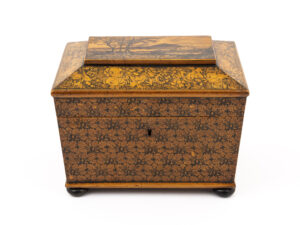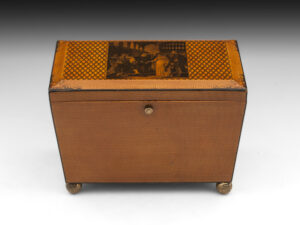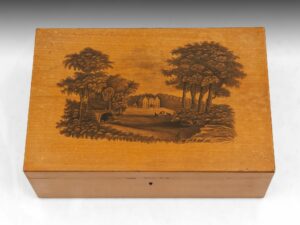Stiven
The Scottish maker Stiven, was associated with Mauchline ware, a distinctive type of Scottish souvenir woodenware produced mainly in the 19th century. Mauchline ware originated from the town of Mauchline in Ayrshire, Scotland, and became famous for its high-quality decorative items made primarily from wood, often sycamore. These items were typically small and functional, like snuff boxes, sewing kits, needle cases, and other personal items. They became popular souvenirs, especially among tourists visiting Scotland.
Key Points About Stiven and Mauchline Ware
J. Stiven & Sons: The Stiven family, particularly under the business name J. Stiven & Sons, was one of the prominent manufacturers of Mauchline ware. Operating in Laurencekirk, Kincardineshire (rather than Mauchline itself), the Stiven company produced many of the traditional Mauchline ware items and contributed significantly to the variety and popularity of this craft.
Design Characteristics:
Transfer Prints and Tartan Designs: Mauchline ware was often decorated with transfer prints of famous landmarks, making it highly collectible for tourists. Stiven and other makers frequently used tartan patterns, which added a distinctly Scottish feel to the items.
Photo Transfer and Lacquer Techniques: Some pieces featured photographic prints on their surfaces, as well as beautifully lacquered finishes that enhanced the grain of the wood.
Other Decorative Styles: In addition to tartan and photographic images, Stiven’s Mauchline ware also included designs with scenes from nature, famous poems, or motifs reflecting Scottish pride.
Tourism Influence:
During the 19th century, tourism in Scotland increased, partially thanks to the romanticization of the Scottish Highlands and heritage. The demand for Mauchline ware as souvenirs grew, and Stiven’s items were among those cherished by travelers looking to bring a piece of Scotland home.
End of Production:
Mauchline ware’s popularity began to decline in the late 19th century as new materials and manufacturing methods emerged. By the early 20th century, the tradition had nearly vanished, and many of the businesses, including Stiven’s, ceased production.
Legacy of Stiven’s Mauchline Ware
Today, Mauchline ware, including pieces produced by Stiven, is highly collectible and valued by antique enthusiasts for its historical and cultural significance. Each piece serves as a small artifact of Scottish heritage, often bearing the marks of fine craftsmanship and the unique charm of a bygone era.
Stiven
The Scottish maker Stiven, was associated with Mauchline ware, a distinctive type of Scottish souvenir woodenware produced mainly in the 19th century. Mauchline ware originated from the town of Mauchline in Ayrshire, Scotland, and became famous for its high-quality decorative items made primarily from wood, often sycamore. These items were typically small and functional, like snuff boxes, sewing kits, needle cases, and other personal items. They became popular souvenirs, especially among tourists visiting Scotland.
Key Points About Stiven and Mauchline Ware
J. Stiven & Sons: The Stiven family, particularly under the business name J. Stiven & Sons, was one of the prominent manufacturers of Mauchline ware. Operating in Laurencekirk, Kincardineshire (rather than Mauchline itself), the Stiven company produced many of the traditional Mauchline ware items and contributed significantly to the variety and popularity of this craft.
Design Characteristics:
Transfer Prints and Tartan Designs: Mauchline ware was often decorated with transfer prints of famous landmarks, making it highly collectible for tourists. Stiven and other makers frequently used tartan patterns, which added a distinctly Scottish feel to the items.
Photo Transfer and Lacquer Techniques: Some pieces featured photographic prints on their surfaces, as well as beautifully lacquered finishes that enhanced the grain of the wood.
Other Decorative Styles: In addition to tartan and photographic images, Stiven’s Mauchline ware also included designs with scenes from nature, famous poems, or motifs reflecting Scottish pride.
Tourism Influence:
During the 19th century, tourism in Scotland increased, partially thanks to the romanticization of the Scottish Highlands and heritage. The demand for Mauchline ware as souvenirs grew, and Stiven’s items were among those cherished by travelers looking to bring a piece of Scotland home.
End of Production:
Mauchline ware’s popularity began to decline in the late 19th century as new materials and manufacturing methods emerged. By the early 20th century, the tradition had nearly vanished, and many of the businesses, including Stiven’s, ceased production.
Legacy of Stiven’s Mauchline Ware
Today, Mauchline ware, including pieces produced by Stiven, is highly collectible and valued by antique enthusiasts for its historical and cultural significance. Each piece serves as a small artifact of Scottish heritage, often bearing the marks of fine craftsmanship and the unique charm of a bygone era.
Showing all 3 resultsSorted by latest



